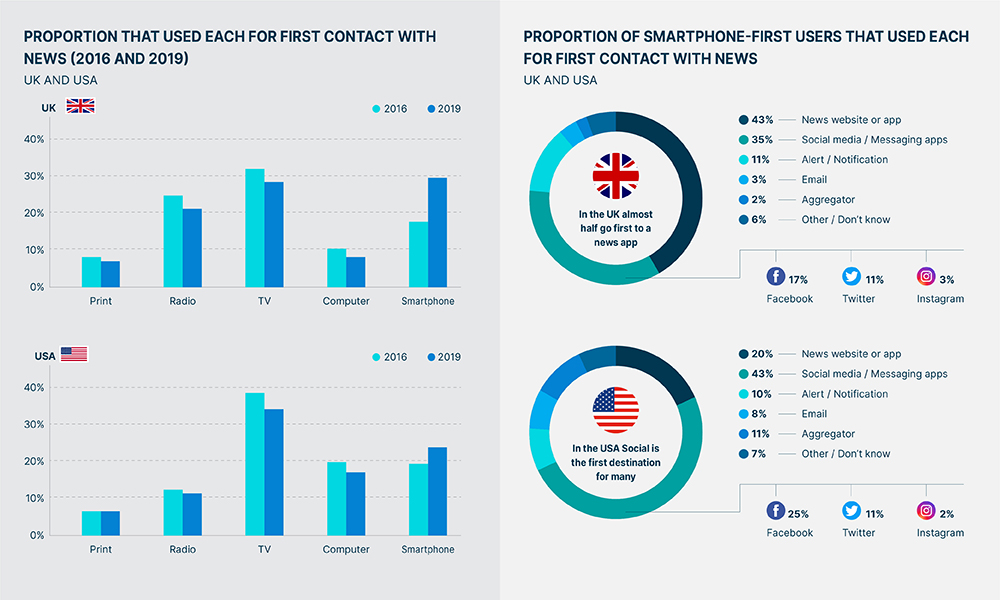Users’ changing behavior of information reception and interaction is a challenge but also an opportunity for the Communication industry.
Few industries are undergoing a transformation as thorough and dramatic as the journalism industry. The technology-led and technology-enabled revolution has irrevocably changed how people interact, how communities are formed, and how news and opinions are shared. Alongside exciting, new possibilities, the changing global media landscape has also brought about many challenges for global news organizations.
The Fall of Traditional News and The Rise of Social Media
One of the biggest challenges facing publishers today is how to make money from news media. Print circulation has been in decline for many years, as is TV and radio. A 2018 research from Pew Research Center revealed that: when asked where they got news the previous day, 70% of participants answer: “either online or through social media”. One-third of the respondents who say they read a newspaper accessed it through a web-based platform.

Although online news consumption is ubiquitous, the same research shows that only 5% to 8% of consumers are willing to pay for them. Particularly not when social media platforms, such as Facebook or Youtube, are enabling extraordinarily more choices and access to news and entertainment at zero cost. These platforms also heavily compete with news sites for digital marketing revenue, leveraging both lower costs and more accurate audience targeting. In the US alone, Google and Facebook command about 60% of all digital advertising revenue.
With an exponential growth rate and 4.388 billion global users in 2019, the social media behemoth shows no sign of slowing down.
Meeting the Demands of Generation C (C for Content)
Contrary to popular belief, what we’re seeing isn’t a crisis of journalism but rather the death of its old business model. In fact, globally, more people are consuming news and the interest for reporting is at an all-time high. According to a 2018 survey by Morning Consult, 40% of Americans are either interested or very interested in the news – a record in over 30 years. The actual reason consumers are switching their media consumption habits is therefore, because their demands are being better met online, through social media.

The new generation of consumers, dubbed Generation C (for Content), have higher expectations than ever. They want more content, they want it now and moreover, they want authenticity, community and quality; delivered through innovative technology. Legacy news outlets as well as online news organizations are struggling to keep up with these evolving needs.
Meanwhile, agile social platforms with their citizen reporters, bloggers and independent content creators, are thoroughly taking advantage of the shifting paradigms. For instance, in 2018 Google made $4.7 billion off of news content alone — almost as much as every news organization in America combined.
Opportunities for Digital as an Enabler of Journalism
It’s clear that the reinventions of journalism in the past two decades have not been driven mainly by reporters and editors, but instead by tech companies. To reclaim their position as leaders of the industry, the news media is fully embracing digital transformation.
One key area of focus is Artificial Intelligence. AI-driven automated fact checkers for example, are already being applied as large-scale responses to online misinformation. By optimizing their fact-checking capability, news organizations are playing to their strength as credibility remains traditional media’s primary advantage. Morning Consult reports that in 2019, amidst growing backlash to “fake news”, 65% of consumers still trusts traditional media compared to only 43% for social media news content. Taking AI applications even further, outlets such as Associated Press are publishing sports stories and weather reports written by computers while Xinhua, the Chinese’ state news agency, is experimenting with producing news broadcasts with virtual news anchors.
Another big industry disruptor is immersive journalism. Using cutting-edge technology from voice driven assistants to smart wearable devices, leading news organizations are delivering high quality, trans-media reporting experiences that justify new reader-driven business models. With AR capable phones for example, CNN has unlocked the potential of immersive mobile storytelling to create more emotionally impactful stories than ever. Their audience reports higher engagement, increased trust in the subject matter depicted and a 25% increase to conversion rate into paying readers.
Conclusion: A New Hope
As social platforms rebuild credibility around privacy and the quality of their content after 2019, traditional media has found a unique opportunity to retake their market leading position. Within the next few years, professional news organizations can win back audiences by innovating content quality and user experience, as the digital native Gen C consumers grow fatigued with low quality click-bait that has devalued journalism. By combining new core business models with the new wave of digital technologies, news publishers can maximize their productivity, profitability and potential to create more engaging and reputable reporting going forward. Though not without challenges, a potential journalism renaissance is slowly taking shape.



